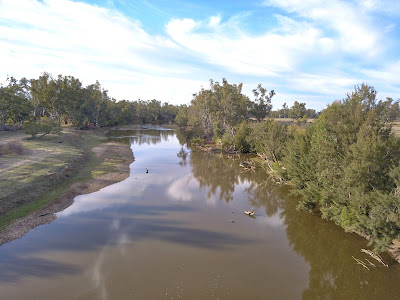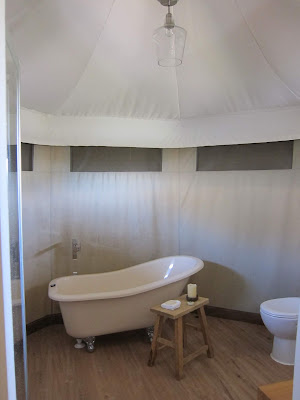Our van spent two days at the Bushtracker factory in early September, where two items were replaced under warranty and additional items were fitted. We also encountered an issue with our hot water system, but a hot water and gas service quickly resolved this troublesome problem.
While the van was receiving some much-needed TLC, we took a break. We stayed at the Rivershore Resort in one of their luxury safari tents equipped with all the modern comforts. The resort is a 15-minute drive from the factory, and the restaurant offers breakfast, lunch, and dinner.
Rivershore
Our Camec 4 kg washing machine stopped working about a month ago, and we've been experiencing issues with our DVD player.
You can imagine our surprise when we found out that the washing machine had a two-year warranty, while the Fusion DVD player was covered for three years. Two brand-new items were installed at no cost. Talk about happy days.
We also installed two rear stabiliser legs along with a bike rack that fits behind our generator box. It was supplied by South East Stainless, which is located just down the road from the Bushtracker factory.

It was a short drive north to Cooroy, where we spent three days camping near this charming little town.
The Cooroy RV stop is for fully self-contained vans with no power available and requires all water to be stored onboard. It's lovely and quiet, with a dump point 100 metres away and fresh town water. At $10 per night, it suits us perfectly.


We left Cooroy on a Monday morning, heading south along the Bruce Highway as far as the Landsborough turnoff. This road runs parallel to the highway, offering a quieter alternative. From here, we took Peacheaster Road, which eventually joins the D'Aguilar Highway just north of Woodford.
From there, we headed west on the D'Aguilar Highway through Kilcoy and onwards to Blackbutt for a quick stop at the bakery before turning south at Yarraman. We briefly followed the New England Highway through Cooyar and Wutul before heading cross-country on minor roads to spend the night at the Jondaryan Woolshed.
The woolshed is heritage-listed, the oldest operating woolshed in the world, built in 1859. We camped by Oakey Creek, but at $22.50, we thought that was a bit much, considering we used all our own facilities.
A quick stop outside the Nindigully Pub for a coffee break before heading south to camp at Thallon.
We passed through Thallon in June while heading to the Big Red Bash at Birdsville in July, but we are staying here for the evening to photograph the art on the nearby silos.
These silos are the first to be painted in Queensland and the first operational silos in Australia to be painted.
It was wonderful to set off this morning without the strong winds we've experienced over the past two weeks. There was just a gentle breeze at the tops of the trees that persisted throughout the day.
We headed south towards Mungindi. From just north of the town, we turned south-west towards Collarenebri. Along the way, we stopped to see the One Ton Post beside the Barwon River, 8 km west of the town.
This post is the largest survey peg in Australia and was erected by John B Cameron in 1881. Cameron's Corner, where the three states meet, is named after him. It marks the eastern end of the 700 km long fence that divides New South Wales from Queensland along the 29th parallel.


The first 40-odd kilometres towards Collarenebri and the last 15 kilometres before reaching the town are bitumen. In between, it is quite a good dirt road with only a few corrugations, but most of this is covered with quite deep bulldust.
Our plan was to camp on the Barwon River west of town for three days. However, the drought has really taken hold of this area, as has much of the country we have passed through on this holiday. It's very depressing passing by properties where the cattle and sheep are being fed because the paddocks have no grass, just dirt.
From Moree, it wasn't too much further towards Gum Flat Reserve on the Gwydir River. We have stayed here before and have another lovely site along the river. There is an eco-toilet and rubbish bins.



After reading discussions among other Bushtracker owners, we decided to buy a Snow Peak fire pit from Drifta. It is made in Japan from marine 316 stainless steel. The frame that sits over the pit can be adjusted in height to suit different heat levels. After just a week of use, we both agree that it was money well spent. Snow Peak
While our Ryobi reciprocating saw was suited for cutting firewood, we have replaced it with a Stihl battery-operated chainsaw. Although it's not cheap, it will certainly last much longer than the Ryobi tool.
I'm amazed by just how good this product is, with its 12-inch blade and a lithium-ion battery that charges in just an hour. The battery can cut through 100 logs on a single charge. It cuts like a hot knife through butter.
On our final night before heading home, we stayed at Cangai. It’s a free campground on the Mann River, west of Grafton. Although there are no facilities, the river water is suitable for our non-potable tanks.
We returned home after being away for three months, during which we travelled 10,905 kilometres. Our fuel efficiency averaged 20.2 L/100 km, with the Big Red Bash at Birdsville being a particular highlight.




















































